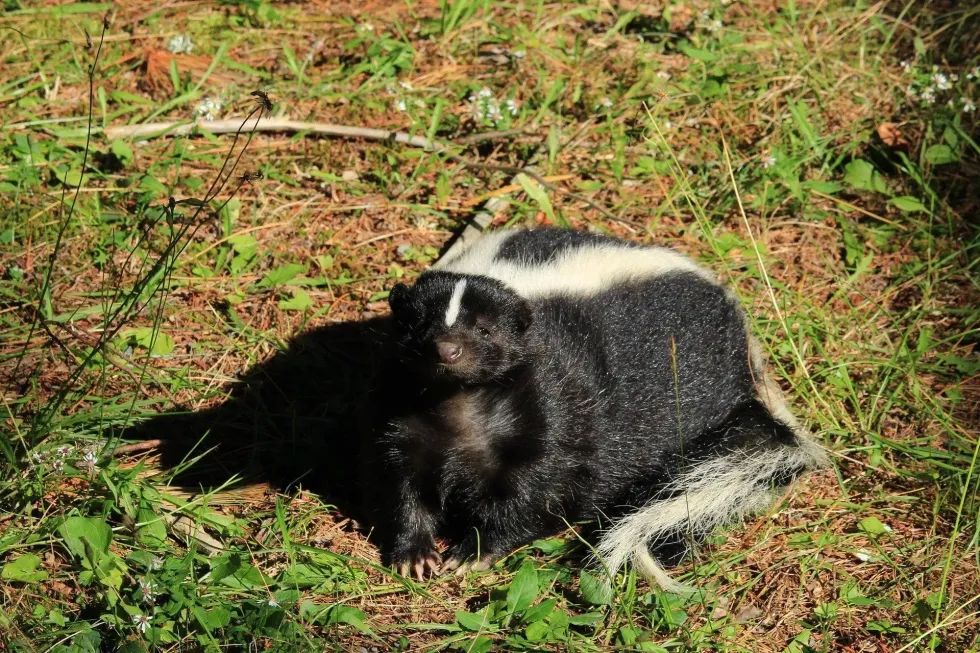Skunks are beautiful black and white striped-furred animals with a unique self-defense mechanism.
Skunks are mammals in the family Mephitidae and are closely related to other mammals like polecats, weasels, or stink badgers. Skunks are primarily found in Mexico, Canada, South America, and United States.
Have you ever witnessed a skunk, or can you identify a skunk? If your answer is no, then why not learn more about skunks? So that when you happen to see one, you may very well know how exactly skunks look.
Skunks belong to the Animalia kingdom. Their habitat includes mountains, deserts although they avoid thick forests.
Skunk is an omnivore animal, and it preys on insects, larvae, and plants. Skunks are natural burrowers in search of grubs and worms. They are nocturnal animals and go out in search of their prey at night.
A skunk's spray is so powerful that it can target its prey more than 10 ft. (3.04 m) away, and it can cause temporary blindness and irritation, and this pungent smell can be detected by a human nose very easily. Skunk enemies can even lose their life.
Skunks leave a wrong impression on others because of their spraying ability with a lousy odor liquid from the anal glands. Skunks mate in spring and give birth in May. The gestation period lasts for two months.
Females give birth to the young ones, and the baby skunk is called a kit. Skunks have litters of 2-10 kits at a time.
The mothers take care of the kits, and the kits also prefer to stay with their mothers. They have a short life span of seven years in the wild. In captivity, it can reach up to 10 years.
There are various types of skunks. The most popular skunks are striped skunks, spotted skunks, hog-nosed skunks, and hooded skunks. These animals differ slightly in habit and appearance. Let's learn more about skunks:
Striped Skunks: These skunks are short and small in size mammals like a cat about 8-19 in(20-48 cm) and weigh about 7 oz to 14 lbs. (198 g to 6.3 kg). Striped skunks have black and white fur, and few are brown or gray.
These black and white stripes' coat runs from the tip to the tail. This coat makes it easy to recognize these species.
Their tail is similar to that of a squirrel. Each foot has five toes as well as claws to dig the ground. They prefer to live in wide-open lands and can be seen on agricultural lands.
Spotted Skunks: Scientifically known as genus Spilogale, spotted skunks are primarily found in hardwood, shrubbery, and forests of North America. They prefer to live in rocky and woody habitats and natural cavities.
They prefer dark places. They are small in size, grow between one to two ft.(0.30-0.60 m) in length, and weigh around one and a half pounds. Spotted skunks have a white spot on their forehead, and their fur is black with white stripes.
These animals are omnivorous, and their food consists of small fruits, berries, rodents, and insects. These spotted skunks use their claws to climb trees.
Hog-nosed Skunk: These animals are found in the Southwest, including Arizona, New Mexico, and southeastern Texas. Hog-nosed skunk has a broad nose, a single stripe on their back, and a white tail and is big than other species of skunks.
They are three ft. (0.91 m) long. They live in open grassy areas. They hunt in the dark and take a rest in their dens during the day.
They are great climbers. They feed on vegetation, and their other food menu consists of insects like small fruits, plants, berries, rodents, and reptiles.
Hooded Skunk: Hooded skunks are found in southwestern New Mexico, southeastern Arizona, and southwestern Texas. They live in grasslands, forests, deserts and are often found near a water source.
These species are comparatively smaller and leaner than other skunks. They have sharp teeth, triangle shape face, and their tail is longer than their body. Their diet menu consists of insects, rodents, shrews, and plant matter.
If you like reading interesting facts about the food animals eat, why don't you check out what eats butterflies? And what eats frogs?
Common Skunks Predators
No matter how beautiful these skunks are, they are very dangerous to anyone who tries to harm them. Skunks are a kind of animal that has a unique system of self-defense mechanism. Many species attack skunks like foxes, puma, coyotes, American badgers, and various birds.
So do raccoons eat skunks? You may get surprised to know that skunks and raccoons are neither enemies nor friends, and they both have similar habits. They like climbing to escape from the attack of their predators, and they are nocturnal. They dig grounds for small worms as their food.
Common Skunks Enemies
Skunk is an omnivorous animal, although they consume both plants and animals and are easily adaptable to any diet. Their primary diet menu consists of larvae, insects, rodents, frogs, birds, eggs, and they also eat berries, leaves, grasses. Sometimes in winter, when they do not find anything to eat, they eat the garbage left by humans.
Despite being so, powerful skunks can still become prey to several predators. However, the exact number of species that prey on skunks is unknown. Coyotes, mountain lions, badgers, foxes, dogs, and giant owls are the enemies of skunk. Here are a few predators of skunks that eat skunks:
Red fox: The red fox is mainly found across the entire Northern Hemisphere and is the predator of skunks. Among other species of fox, red foxes are extraordinary predators.
The red foxes are carnivorous animals, and their diet consists of a wide variety of food like birds, eggs, raccoons, and rabbits. Their extraordinary ability to smell and hear does help them to haunt their prey.
Great horned owl: The great horned owls are similar to other species of owls, although their color might vary slightly. Their unique color provides them camouflage in the woods and protects them from their predators.
The horned owl is carnivorous, and they have a flexible diet consisting of insects, small animals, and skunks. Owls are not bothered about the odor, and they attack skunks.
These birds are known for their hunting skills. They have a great vision and are nocturnal birds. They target their prey by using their sharp talons to hold and crush their bodies.
The great horned owls are skunks' natural and regular predators as they cannot see the owls coming from high. However, they can protect themselves if they get alarmed.
Red-tailed hawk: The red-tailed hawks are primarily found in the interior of Alaska and northern Canada. The red-tailed hawks are a carnivore, and their diet consists of small mammals, birds, and fish.
These hawks eat skunks too. They hunt them from a mile away with such a speed that the skunks' defense mechanism cannot protect them on time. These owls are real hunters.
Coyotes: Coyotes are found primarily in North America. Their primary habitat is plains and mountains. These coyotes are a medium-sized animal that resembles a wolf and jackal.
These species are also known as American jackals. It can run fast at a speed of 40 mph(64.3 kph). These are wild animals with a carnivorous diet that prey upon small mammals and attack large animals in groups.
These coyotes also hunt skunks, but sometimes they fail to attack due to the foul smell sprayed by the skunks. However, these coyotes can overcome the smelly skunk with their speed. It can catch the skunk with its powerful teeth, bite it and kill it.
Cougars: Cougars are the fourth largest species in the world. These species are primarily found in the rocky deserts and forests of Canada and South America. They resemble large cats.
They are carnivores, and they mainly depend upon a meat diet. It can run at a speed of 40-50 mph (64.3-80.4 kph). Cougars hunt skunks with their powerful jaws, hold them with their large hind legs, bite their neck and kill them.
Domestic dogs: Last but not least, dogs are also capable of eating a skunk.
Other Dangers To Skunks

Skunk is a strong animal that struggles hard to escape from its predators. Skunks are not aggressive, and they do not harm us unless we harm them.
They become dangerous when they are cornered or defending their young. The skunk will not spray directly; it will spit, fluff its fur, growl, shake its tail, and stamp the ground. If the predators do not leave, the skunk will then lift its tail and spray its famous skunk bad smell spray.
As per the U.S. Centers for Disease Control and Prevention, it has been proved that skunks are one of four wild animals (including the raccoon, bat, and fox) that can spread some harmful diseases like rabies, distemper, and salmonella. These diseases can spread among unvaccinated dogs and cats.
To control rabies, humans are also a threat to them as they can kill them.
Other dangers to skunks responsible for limiting skunk populations apart from the disease are environmental conditions like severe drought or winter, anthropogenic activities, chemicals to kill a skunk, patterns of survival.
How do skunks protect themselves from predators?
The life of a skunk is not easy to live; although they are strong, skunks have a unique self-defense mechanism to threaten other animals. So how does this animal survive in the wild? What do you think?
A skunk has several ways to protect itself, although the main trick they use is their smell.
Skunks are very well known for their toxic liquid spray that has a strong, foul-smelling spray that comes from the anal glands, and this spray is used to turn away themselves from the predators of skunks. Because of this terrible smell, few species even do not think of eating a skunk.
When the skunks threaten their enemies, they give a warning by lifting their tails, growling, shaking their tails, stamping the ground, and spaying the pungent odor to turn away their hunters and defend themselves.
Skunk has retractable claws to help them clutch their prey. The spotted stripes on its coat are a signal for their enemies to stay away. Some species of skunks can climb trees using their claws to escape from their enemies. These are a few preventions they take to protect themselves from their predators.
Though these species are harmful, they are beautiful, and we should protect them from becoming extinct from the wildlife. In America, in 17 states, skunks can be kept legally as a pet. Their scent glands are removed by the owners when they are kept as a pet.
Here at Kidadl, we have carefully created lots of interesting family-friendly facts for everyone to enjoy! If you liked our suggestions for what eats skunks then, why not take a look at what eats wasps or skunk facts?










